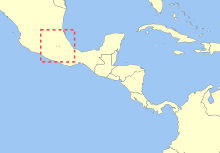
Back أرنب بركاني Arabic ارنب بركانى ARZ Libol (Romerolagus diazi) AVK Вулкански заек Bulgarian Konikl ar menezioù-tan Breton Conill dels volcans Catalan Romerolagus diazi CEB Králík lávový Czech Vulkankaninchen German Vulkankuniklo Esperanto
| Volcano rabbit[1] | |
|---|---|

| |
| At the Chapultepec Zoo in México City | |
| Scientific classification | |
| Domain: | Eukaryota |
| Kingdom: | Animalia |
| Phylum: | Chordata |
| Class: | Mammalia |
| Order: | Lagomorpha |
| Family: | Leporidae |
| Genus: | Romerolagus Merriam, 1896 |
| Species: | R. diazi
|
| Binomial name | |
| Romerolagus diazi (Ferrari-Pérez, 1893)
| |

| |
| Volcano rabbit range | |
The volcano rabbit (Romerolagus diazi), also known as teporingo or zacatuche, is a small rabbit that resides on the slopes of volcanoes in Mexico.[4] It is the world's second-smallest rabbit, second only to the pygmy rabbit. It has small rounded ears, short legs, a large forehead, and short, thick fur. It weighs approximately 390–600 g (0.86–1.3 lb) and has a life span of 7 to 9 years. The volcano rabbit lives in groups of 2 to 5 animals in burrows (underground nests) and runways among grass tussocks. The burrows can be as long as 5 m and as deep as 40 cm. There are usually 2 to 3 young per litter, born in the burrows. In semi-captivity, however, they do not make burrows and the young are born in nests made in the grass tussocks.[5]
Unlike many species of rabbits (and similar to pikas), the volcano rabbit emits high-pitched sounds instead of thumping its feet on the ground to warn other rabbits of danger. It is crepuscular and highly active during twilight, dawn and all times in between. Populations have been estimated as approximately 1,200 individuals in 150–200 colonies over their entire range.[6]
- ^ Hoffman, R.S.; Smith, A.T. (2005). "Order Lagomorpha". In Wilson, D.E.; Reeder, D.M (eds.). Mammal Species of the World: A Taxonomic and Geographic Reference (3rd ed.). Johns Hopkins University Press. p. 207. ISBN 978-0-8018-8221-0. OCLC 62265494.
- ^ Velázquez, A.; Guerrero, J.A. (2019). "Romerolagus diazi". IUCN Red List of Threatened Species. 2019: e.T19742A45180356. doi:10.2305/IUCN.UK.2019-2.RLTS.T19742A45180356.en. Retrieved 12 November 2021.
- ^ "Appendices | CITES". cites.org. Retrieved 2022-01-14.
- ^ Hoth, J., A. Velázquez F. Romero, L. León, M. Aranda and D. Bell, 1987. The Volcano Rabbit- a Shrinking Distribution and a Threatened Habitat. Oryx. IUCN. 21 (2): 85–91 https://www.researchgate.net/publication/232022237_The_volcano_rabbit_-_A_shrinking_distribution_and_a_threatened_habitat
- ^ Hoth, J. and H. Granados, 1987. A Preliminary Report on the Breeding of the Volcano Rabbit (Romerolagus diazi) at the Chapultepec Zoo, Mexico City. International Zoo Yearbook. 26:261-265. https://www.researchgate.net/publication/229843031_A_preliminary_report_on_the_breeding_of_the_Volcano_rabbit_Romerolagus_diazi_at_the_Chapultepec_Zoo_Mexico_City
- ^ Velazquez, Alejandro (1994). "Distribution and Population Size of Romerolagus diazi on El Pelado Volcano, Mexico". Journal of Mammalogy. 75 (3): 743–749. doi:10.2307/1382525. JSTOR 1382525.
